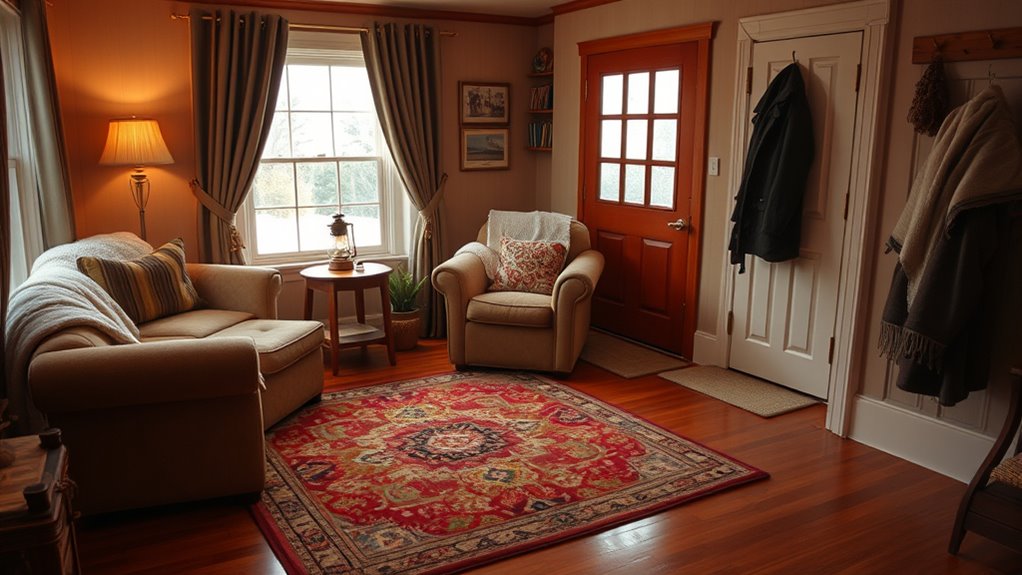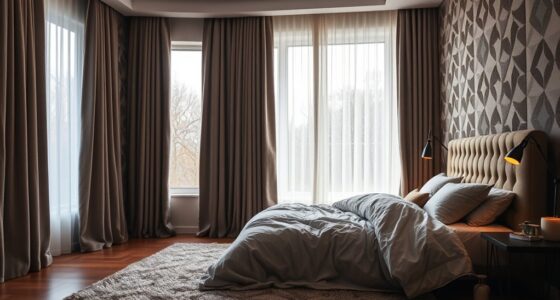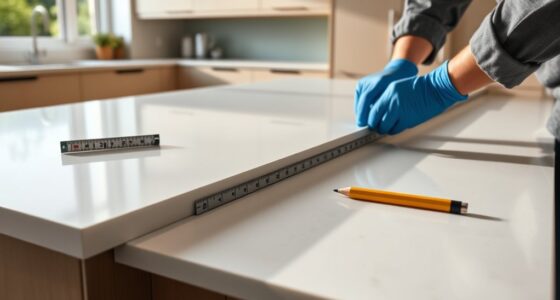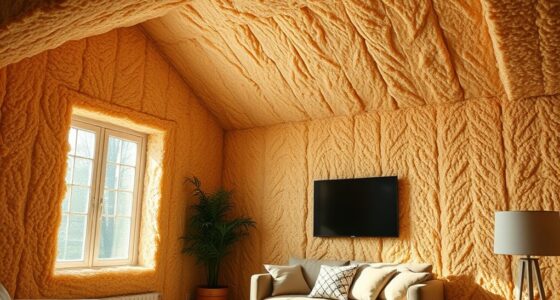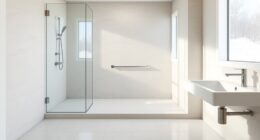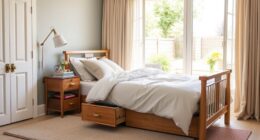To winterize your home for older occupants, start by evaluating and insulating windows and doors to prevent drafts. Seal leaks with weatherstripping and install storm windows for added warmth. Upgrade your heating system and use smart thermostats for better control. Keep pathways clear and install non-slip mats to prevent falls. Regularly check detectors and keep emergency supplies ready. For more safety tips and adjustments, continue exploring how to create a warm, accessible home environment.
Key Takeaways
- Insulate windows and doors, seal drafts, and install storm windows to prevent heat loss and improve energy efficiency.
- Upgrade to smart thermostats and consider radiant heating for consistent, safe, and energy-efficient warmth.
- Keep pathways clear of snow, ice, and clutter; install non-slip flooring and handrails to prevent falls.
- Install smoke and carbon monoxide detectors, and perform regular maintenance and safety checks.
- Enhance outdoor lighting and obstacle-free hallways to improve visibility and accessibility during winter months.
Assessing and Insulating Windows and Doors

Since windows and doors are common sources of heat loss, it’s essential to assess their condition before winter sets in. Start by inspecting for gaps, cracks, or damaged frames that allow cold air to seep in. Installing storm windows is a smart move; they add an extra layer of insulation and protect your existing windows from drafts. Additionally, applying window film can notably reduce heat transfer through glass, keeping your home warmer and more energy-efficient. Make sure the storm window installation is secure and the film adheres well without gaps. These simple steps help prevent heat loss, making your home more comfortable for older occupants and lowering heating costs. Regularly check these measures throughout the season to ensure continued effectiveness. Utilizing professional services can further optimize your home’s insulation and energy efficiency.
Sealing Drafts and Air Leaks
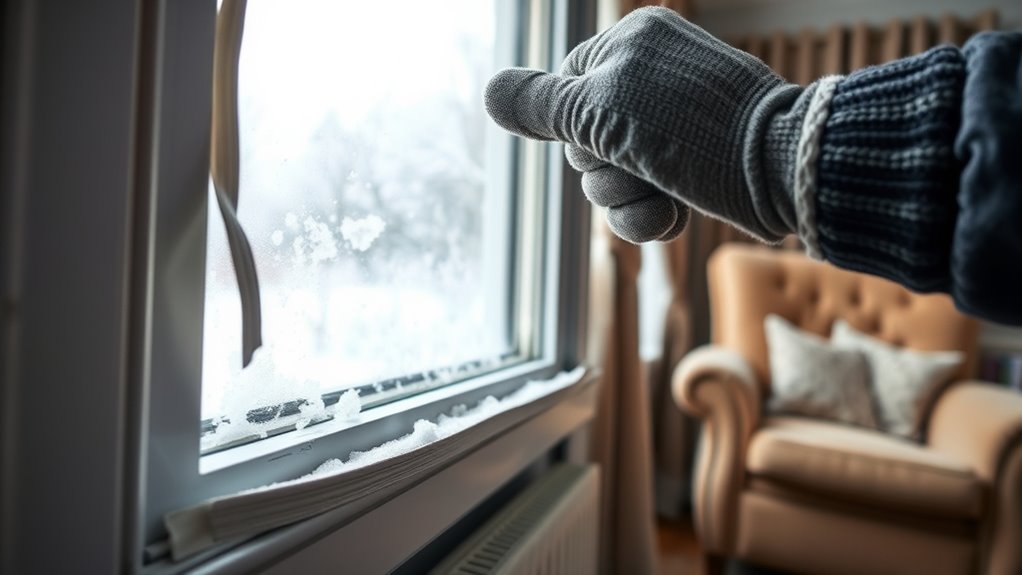
After inspecting and insulating your windows and doors, the next step is to address drafts and air leaks that can undermine your efforts. Sealing gaps around windows, doors, and other openings helps prevent cold air from entering and warm air from escaping. Use weatherstripping or caulking to seal leaks effectively. This not only keeps your home warmer but also aids in dampness control, reducing the risk of excess moisture that can lead to mold growth. Ensuring airtight seals prevents cold drafts that can make older occupants uncomfortable and unwell. Regularly check for new leaks after storms or temperature fluctuations. Proper sealing is a simple, cost-effective way to enhance home comfort, improve energy efficiency, and maintain a healthier indoor environment during winter. Incorporating vertical storage solutions and multi-functional furniture can also maximize space and reduce clutter, contributing to a more comfortable living environment.
Upgrading Heating Systems and Thermostats
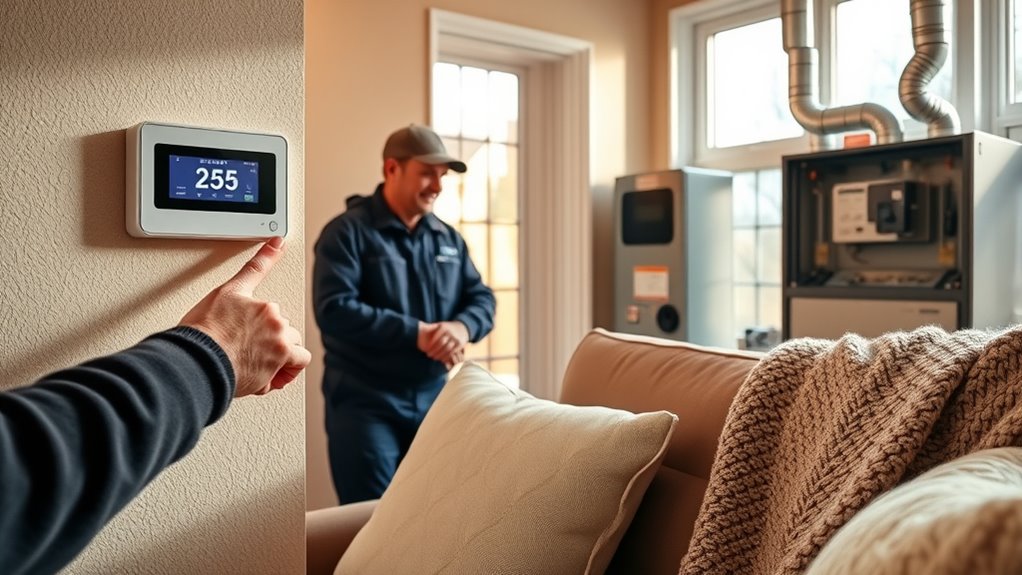
Upgrading your heating system and thermostats can considerably improve comfort and energy efficiency during the winter months. Installing smart thermostats allows you to easily control your home’s temperature remotely, set schedules, and optimize energy use, which benefits older occupants by maintaining consistent warmth. Consider radiant heating systems, which provide direct warmth through floors or walls, reducing cold spots and creating a cozy environment. These systems are especially effective for seniors who may have mobility issues, as they eliminate the need to adjust traditional radiators or heaters constantly. Modern heating upgrades can enhance safety by reducing the risk of uneven heating or fires. Utilizing sound design techniques in the installation process, such as tuned acoustics and noise reduction measures, can further improve the overall comfort of your home. By choosing energy-efficient options, you’ll enjoy lower utility bills and a more comfortable, safer home throughout the winter.
Ensuring Safe and Clear Pathways
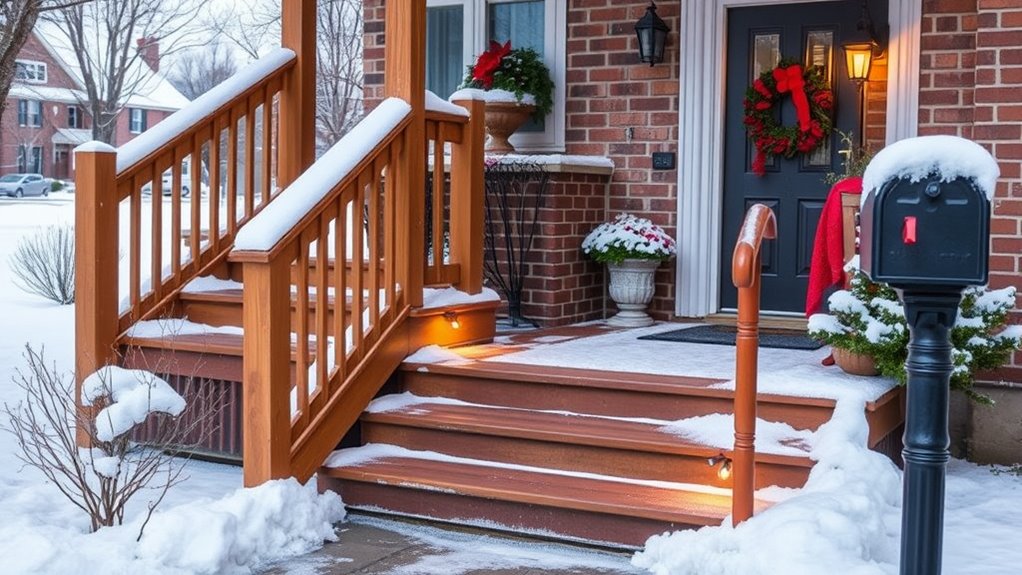
To help prevent falls and accidents during winter, it’s essential to keep pathways around your home safe and clear of hazards. Regularly clear snow and ice from walkways, driveways, and stairs. Ensure outdoor lighting is functional and bright enough to illuminate potential obstacles, especially near the fire exit. Keep pathways free of clutter, leaves, and debris that could cause slips. Install handrails along stairs and ramps for added support. Mark pathways clearly with reflective tape or signs. Check that the fire exit remains accessible at all times, unobstructed, and well-lit. Proper maintenance of outdoor spaces is crucial for grocery savings strategies, as it reduces the risk of costly accidents and ensures safety for all occupants.
Installing Non-Slip Flooring and Mats

Installing non-slip flooring and mats is a practical step to reduce the risk of slips and falls inside and outside your home during winter. Non-slip flooring provides better traction on stairs, bathroom floors, and entryways, where wet surfaces can be dangerous. Safety mats placed in high-traffic or wet areas add extra grip and cushioning, minimizing accidents. Choose materials like textured vinyl, rubber, or treated wood to guarantee slip resistance. Regularly check and clean your safety mats to maintain their effectiveness. By upgrading to non-slip flooring and adding safety mats, you create a safer environment for older occupants, especially when icy conditions make surfaces slick. Digital literacy programs can also encourage playful communication among seniors, helping them stay connected and confident in their mobility. These simple modifications considerably reduce fall risks and promote confidence moving around your home during winter.
Maintaining Chimneys and Ventilation Systems

Regularly inspecting and cleaning your chimney and ventilation systems is essential for safe and efficient operation during winter. Schedule chimney cleaning to remove soot buildup and prevent blockages that could cause dangerous smoke backdrafts or fires. Make sure your chimney cap is intact to keep debris and animals out. Conduct ventilation checks to ensure airflow remains unobstructed, reducing indoor air pollutants and moisture buildup. Clean or replace filters in exhaust fans and ventilation systems to maintain air quality. Clear vents of any debris, bird nests, or obstructions. Proper maintenance minimizes fire risks and improves heating efficiency. Regular upkeep not only keeps your home safe but also guarantees that older occupants breathe cleaner air and stay warm comfortably throughout the season. Additionally, understanding high contrast ratios can help you select and maintain your heating and ventilation systems more effectively, ensuring optimal performance and safety.
Preparing Emergency Supplies and Equipment
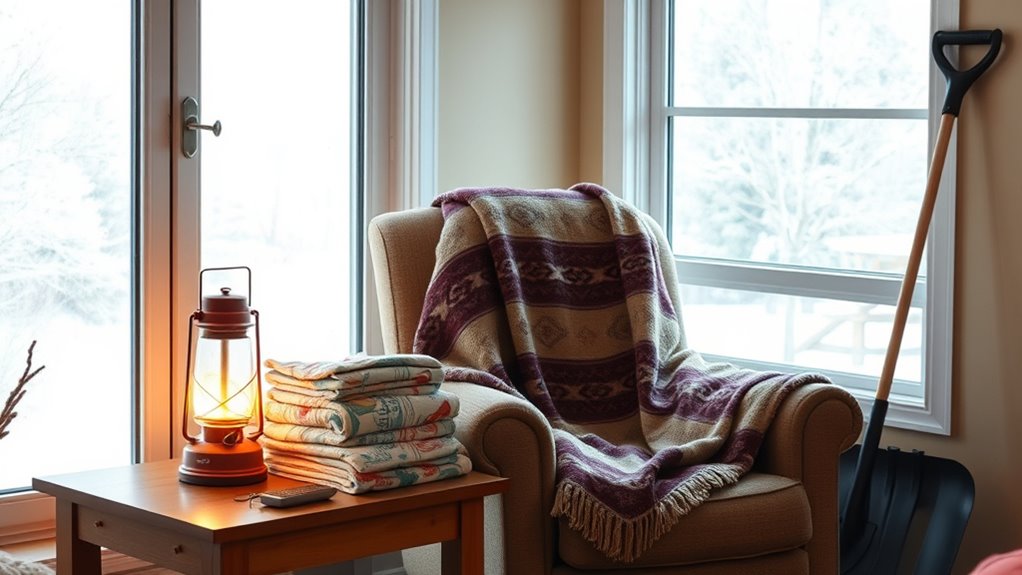
Preparing emergency supplies and equipment is a crucial step to guarantee safety and comfort during winter storms or power outages. You should assemble an emergency kit with essentials like bottled water, non-perishable food, batteries, flashlights, and a first aid kit. Include necessary medications and warm blankets to stay comfortable. Developing a communication plan is equally important—make sure everyone knows how to contact each other and has a list of emergency contacts. Keep a portable phone charger handy and consider a battery-powered radio to stay updated on weather alerts. Regularly check and replenish supplies to make sure everything is ready when needed. Proper preparation minimizes stress and helps protect older occupants from winter hazards, ensuring everyone stays safe and warm during emergencies. Additionally, understanding hydrotherapy techniques can help manage stress and promote relaxation during stressful winter conditions.
Checking and Maintaining Carbon Monoxide and Smoke Detectors

After assembling your emergency supplies, it’s equally important to guarantee that your safety devices are functioning properly. Start by performing alarm testing on your smoke and carbon monoxide detectors to ensure they sound correctly. Replace batteries if needed, ideally every six months, and consider using detectors with long-life batteries for added convenience. Check detector placement to maximize safety; smoke alarms should be installed on every level and outside sleeping areas, while carbon monoxide detectors belong near bedrooms and fuel-burning appliances. Regular maintenance helps catch issues early and keeps your home safe during winter months. Keep a checklist and schedule routine checks to ensure your detectors are always ready to alert you in an emergency. Proper alarm testing and strategic detector placement are essential for protecting older occupants during winter. Routine maintenance is also vital to ensure that detectors function properly over time and provide reliable alerts when needed.
Creating a Warm and Accessible Living Environment

Have you considered how small changes can make your home warmer and more accessible for older occupants? Start by choosing decorative window treatments that insulate better and reduce drafts. Next, update outdoor lighting options with motion-activated or solar-powered lights to enhance safety and visibility. You should also:
Small changes like insulating window treatments and improved outdoor lighting can boost comfort and safety for older loved ones.
- Install slip-resistant rugs and mats to prevent falls.
- Ensure doorways and hallways are well-lit and clear of obstacles.
- Add handrails along stairs and in bathrooms for support.
- Use warm, energy-efficient blankets and thermal curtains to boost comfort.
- Adjust the optimal angles of pinball machines to reduce strain on players and make gameplay more comfortable during extended sessions.
These simple adjustments create a cozy, safe environment, making winter easier for your loved ones. Small enhancements like these considerably improve accessibility and warmth without extensive remodeling.
Frequently Asked Questions
How Can I Prevent Pipes From Freezing During Winter?
To prevent pipes from freezing, you should insulate them with pipe insulation, especially in unheated areas. Keep your water heater protected by insulating it and setting it to a safe temperature. Letting faucets drip slightly during cold nights also helps prevent freezing. Additionally, open cabinet doors to allow warm air to circulate around pipes. These steps reduce the risk of frozen and burst pipes, saving you costly repairs.
What Are the Best Ways to Boost Indoor Air Quality?
Have you ever wondered if your home’s air is truly healthy? To boost indoor air quality, consider using air purifiers to remove pollutants and allergens. Don’t forget humidity control—keeping the right level prevents mold and dryness. Regularly ventilate rooms and maintain filters. These simple steps make your home safer, more comfortable, and healthier for everyone inside. Isn’t your well-being worth a little extra effort?
How Often Should Heating Systems Be Serviced?
You should schedule maintenance for your heating system at least once a year, ideally before the winter season begins. Regular maintenance schedules include professional inspections to guarantee your system runs efficiently and safely. If you notice any issues like strange noises or uneven heating, don’t wait—schedule an inspection sooner. Routine check-ups help prevent breakdowns, extend your system’s lifespan, and keep your home warm and safe during colder months.
What Are Essential Safety Tips for Elderly Residents in Winter?
Think of winter as a silent guardian, demanding respect. You should remind elderly residents to keep fireplaces safe, never leave fires unattended, and guarantee proper chimney maintenance. Check outdoor walkways for ice, applying salt or sand to prevent slips. Keep emergency numbers handy, and ensure heating devices are used safely. These steps create a shield of security, protecting loved ones from winter’s silent threats and ensuring warmth and safety through the colder months.
How Can I Reduce Energy Costs While Keeping the Home Warm?
To cut energy costs while keeping your home warm, focus on upgrading to energy-efficient windows that retain heat better. Manage your thermostat wisely by setting it lower at night and when you’re away, and use a programmable thermostat for convenience. Seal drafts around doors and windows to prevent heat loss. These steps help you stay cozy without high energy bills, making your home more efficient and comfortable during cold months.
Conclusion
As winter approaches, taking these gentle steps helps create a cozy haven where your loved ones can comfortably enjoy the season’s quiet beauty. By ensuring safety and warmth, you’re nurturing a space that feels both inviting and secure. With a little care and attention, you can transform your home into a comforting retreat—where every corner whispers reassurance and every moment is wrapped in gentle warmth, making winters a time of peaceful togetherness.
